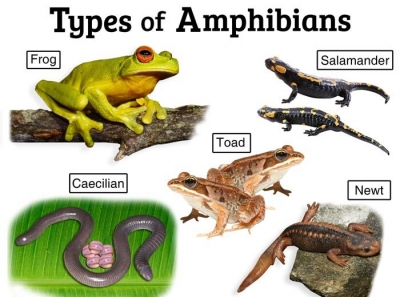
Amphibians begin their life in water, where they breathe with gills. Most amphibians then grow a pair of lungs so that they can breathe when they are on land. They mostly have smooth skin, which must stay moist, so amphibians stay close to wet places when out of water.
Toads
Like frogs, toads are amphibians. They differ from most frogs because they have dry skin, warts, crests behind the eyes, and parotoid glands. The parotoid glands produce a poisonous secretion that helps the toad defend itself from predators. This substance, called a bufotoxin, can cause death in small animals and allergic reactions in humans. Toads have other ways to avoid being eaten too. If they’re brown or green in color, they can blend into their surroundings and escape detection. If brightly colored, they warn predators to stay away because they’re poisonous. Toads also puff up their bodies in an attempt to look bigger and inedible if a predator is nearby.
Frogs
Frogs are amphibians that are known for their jumping abilities, croaking sounds, bulging eyes and slimy skin. They live all over the world and are among the most diverse animals in the world, with more than 6,000 species.
Also, frogs have smooth, slimy skin; toads have dry, bumpy skin. The bumps, however, are not warts, and a person cannot get warts from handling a toad, according to the San Diego Zoo. However, toads have glands behind their eyes that can secrete a burning milky toxin.
Salamanders
Salamanders are amphibians that look like a cross between a frog and a lizard. Their bodies are long and slender; their skin is moist and usually smooth; and they have long tails. Salamanders are very diverse; some have four legs; some have two. Also, some have lungs, some have gills, and some have neither — they breathe through their skin.
The salamander’s habitat depends on what type of salamander it is. Newts typically spend most of their time on land, so their skin is dry and bumpy. Sirens have lungs as well as gills and spend most of their time in water. No matter the species, all salamanders need to keep their skin moist and need to have offspring in water, so a nearby water source is critical.
Caecilians
Caecilians tend to have very small eyes, which are thought only to be able to detect differences between light and dark. In some species, the eyes are completely covered by skin—an adaptation suited to a life spent almost entirely underground. A pair of tiny, chemically-sensitive tentacles on the caecilians’ faces can detect food and possibly help the animals navigate.
Caecilians come in a variety of colors, from grays and blacks to brilliant blues. Some species are two-toned, with purple topsides and pink underbellies. Others boast dozens of vertical stripes, like a coral snake.
Newts
Newts are small semi-aquatic amphibians that look like a cross between a frog and a lizard. Newts possess several interesting characteristics. For example, though they may look cute and harmless, they can be dangerous; toxins secreted through the skin as a defense mechanism could kill a person. Newts also can regrow lost limbs and organs. That ability makes them important subjects in medical studies on regeneration. Also, some newts have flown on space missions.
Axolotl
The axolotl salamander has the rare trait of retaining its larval features throughout its adult life. This condition, called neoteny, means it keeps its tadpole-like dorsal fin, which runs almost the length of its body, and its feathery external gills, which protrude from the back of its wide head.
Axolotls are long-lived, surviving up to 15 years on a diet of mollusks, worms, insect larvae, crustaceans, and some fish. Accustomed to being a top predator in its habitat, this species has begun to suffer from the introduction of large fish into its lake habitat. Natural threats include predatory birds such as herons.
Amphibian facts
- The Chinese giant salamander is the world’s largest amphibian, reaching 1.8 m (6 ft) in length.
- Giant salamanders also live the longest, reaching more than 50 years old.
- The fastest amphibian is the Andean salamander, which has a top speed of 24 kph (15 mph).
Picture Credit : Google




